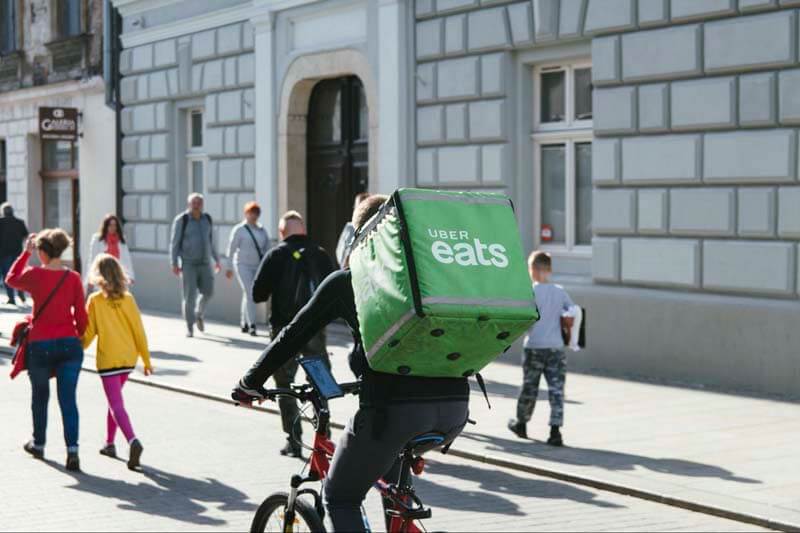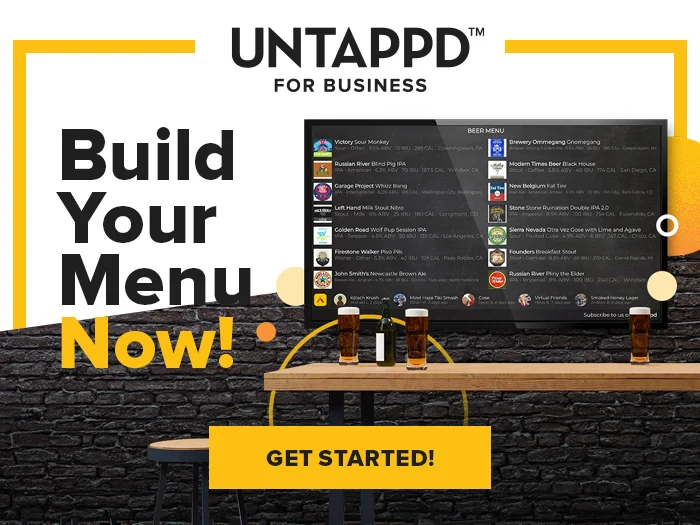
Forbes called it.
While researching food industry trends for 2022, they forecasted that the pandemic would drive a revolution in digital and delivery services by changing how people purchased and received food like curbside pickup, online ordering, and delivery.
Now, it’s a sentiment shared across the industry. Boston Consulting Group reported in the article “The $100 Billion Digital Lifeline for Restaurants” that “Delivery’s market share jumped from 7% in 2019 to about 20% in 2020. Across the industry, digital ordering now represents 28% of all orders compared with 10% before the pandemic, with most brands showing increases.”
As customers continue to order their food online, it’s time for breweries, bars, and restaurants to consider food delivery services (if you haven’t already). Should you develop your own delivery system for your restaurant or lean into a third-party alternative?
We’re breaking down the advantages, disadvantages, and potential revenue streams that a food delivery app can provide to help you consider all your options.
What We’ll Cover in This Piece:
The Two Types of Food Delivery: App- vs. Restaurant-Supplied
When it comes to setting up food delivery, you really have two choices: Do it yourself or hire a third-party service such as UberEats, Postmates, or Grubhub to do it for you.
There are pros and cons to both.

Photo by Daniel Bradley on Unsplash
Working With a Third-Party Delivery Service
Working with a third-party food delivery app means you can tap into an already-proven system. One that has its own app, hires its own delivery drivers, and manages its own customer service.
But remember, in order to get your restaurant ready to accept online orders for the delivery apps, you may have to pay transactional costs or even membership fees as a registered business on the app (anywhere from $0-$400). Always be vigilant when it comes to the fine print!
And by far and away, the biggest disadvantage to working with a third-party food delivery service is that they will take a certain cut of every transaction.
On average, CNET reports that third-party food delivery apps often charge restaurants commissions and fees ranging from fifteen percent to thirty percent of the entire purchase amount.
In fact, it seems that customers actually prefer ordering directly from a restaurant to ensure that businesses reap every penny. Finances Online reports that “sixty-three percent of U.S. consumers say they prefer to order directly from a restaurant, while eighteen percent say they use third-party delivery services. (Sense 360, 2020)”
Creating Your Own Delivery Service
Opting for in-house delivery means you cut out the middleman and collect all the revenue at the end of the day.
No matter how you look at it though, establishing delivery services comes at a price. Even if you decide to handle all the food delivery on your own, expenses can include: purchasing delivery vehicles and food containers, paying for gas, hiring drivers, and even creating customized delivery menus.
But all that labor might result in more revenue if you can get your dishes to more folks in your area at all times of the day!
That’s the business decision you have to weigh. So to help you see the greater picture, we’ve broken down the pros and cons of food delivery.
3 Benefits of Food Delivery Services
Besides the obvious opportunity to service a wider group of customers, there are other benefits to call out.
More Revenue for Your Restaurant
Food technology experts at TouchBistro report that, compared to dine-in orders, delivery orders might result in a staggering twenty percent rise in check sizes for restaurants. As a result, more customers will place larger meal orders at once.
If your restaurant is able to service in-house diners as well as those enjoying your food at their own kitchen tables, your business is essentially doubling its orders, resulting in higher-profit days.
It’s an Effective Way to Promote Your Business
Think of food delivery as a way of casting a much larger net to more customers. Adding your restaurant to a delivery platform allows your business to be promoted and marketed by third-party apps.
You’re exposing your eatery to their combined millions of patrons in neighborhoods throughout your city!
By offering customer service, you not only expand your customer base, but also increase the number of business options available to you.
By letting the food come to them, you’re giving customers an easy, practical method to eat their favorite dishes.
It’s Convenient for Customers
Your customers don’t even have to call your front of house to place an order!
With just a simple click of a button or touch of a screen, your clients can easily place orders whenever they want, from anywhere, making them much safer and more convenient.
If you didn’t offer food delivery services, customers would have to come in person to your establishment to pick up the food they’ve purchased.
3 Drawbacks of Food Delivery Services

Photo by Samantha Fernandes on Unsplash
Since there is no one-size-fits-all solution for the best type of meal delivery service, the question is, should you even use it?
Before you think it’s more convenient to just hand over the delivery responsibilities to a third-party delivery service, here are three big points to consider.
Lack of Quality Control
Consider the route that your dish takes once it leaves the hands of your expert chefs.
There is always a chance that the food won’t make it to your customers at your preferred serving texture or temperature. Fried food might arrive less than crispy. Or salads might wilt under the pressure of travel. Regardless of whether you utilize your own fleet or a fleet that belongs to a third party, you have less control over how the food ends up in front of the customer.
Since customers generally look at restaurant reviews before choosing a restaurant, all of these considerations can add up. This might mean you need to make tweaks to certain dishes or even offer a limited menu for delivery. One full of items you know can stand up to the rigors of travel and make it to your fans as hot and delicious as when it left the kitchen.
With that in mind, it would be wise to consider all the packing options you can invest in to ensure the structure and integrity of your meals during transit.
Think of it like an insurance policy on your plates.
Third-Party Apps Can Take a Bite of Your Profit
It’s true. As we mentioned above, according to a CNET report, it’s a common practice for third-party food delivery apps to charge restaurants fifteen to thirty percent commissions and fees.
Those extra taxes, if you will, can eat up a huge portion of your profit at the end of the day. You need to decide whether you feel it’s worth it for your business.
Double the Work for Your Kitchen Staff
Don’t overlook the potential pressure on your personnel.
Your staff might find it difficult to keep up with the increased demand if there are more orders to complete.
Of course, you don’t want to let down your patrons with protracted wait times or worse—with cold food.
You could restrict your takeout menu to avoid this. Alternatively, you can consider hiring more kitchen employees to specifically prepare and deliver orders.
How to Decide if Food Delivery Benefits Your Business

Photo by Dylan Mullins on Unsplash
All things considered, there are always risks with making a business decision like starting food delivery. Unfortunately in restaurants and hospitality, there is no guarantee of a sure thing or one size fits all.
When it comes to determining if food delivery benefits your business, it’s also a good idea to consider these two things: location and people.
Location, Location, Location
Do you own a restaurant or bar in the city or out in the ‘burbs? Chances are if you’re in an urban area, delivery is a more popular option. If you’re in a more rural area, folks are more likely to have cars and be willing to drive to go out to eat or pick up food.
If you’re a fairly rural restaurant, delivery might not even make sense for you. Check out other establishments in your area to see what they’re doing. If you feel comfortable, reach out to those that already have food delivery operations in place and ask them what they feel are the advantages and disadvantages.
What Do Your Fans and Staff Say?
If you’re still unsure about starting a food delivery, why not just ask your patrons and staff what they think?
Pool your customer base and straight up ask whether they’d prefer ordering for delivery or eating in-house. Or just question how willing they’d be to order food to go at your establishment.
Additionally, check in with your staff. If your team isn’t on board with the proposed change to your order of operations, then maybe pump the brakes on implementing food delivery.
As long as your staff feels supported and equipped with all details, your restaurant will never fail to deliver.
Other Content You May Enjoy
To succeed and grow your restaurant, bar, or brewery you need to stand out in local search results. Whether someone is searching for the “best craft beer near me” or “top-rated seafood restaurant in [your city],” Local SEO (Search Engine Optimization) helps your business appear at the top of those search results.
With 81% of consumers using Google Search and Maps to find local businesses, and nearly 90% of customers choosing a business on the first page of search results, optimizing your online presence is essential.
This guide will walk you through Local SEO strategies tailored for restaurants, bars, and breweries, covering Google My Business, website optimization, online reviews, local backlinks, and more.
By the end of this guide, you’ll have a step-by-step action plan to increase your search rankings, attract more local customers, and grow your business.
In today’s digital world, having a well-designed, functional website is essential for restaurants, bars, and breweries. It goes beyond having social media. A great website can help attract new customers, showcase menus, accept reservations, and even drive online sales. But one of the most common questions business owners ask is: How much should a website cost in 2025?
The answer depends on several factors, including the type of website, features, complexity, and whether you choose a DIY solution or hire a professional web developer. Costs can range from a few hundred dollars for a basic website to tens of thousands for a fully customized, feature-rich platform.
This guide will break down website costs for restaurants, bars, and breweries, helping you understand the pricing landscape and choose the best solution for your business
Trivia nights have become an incredible marketing strategy for bars, restaurants, and breweries to draw in crowds and engage with new customers. With the recent collaboration between Geeks Who Drink, Timeplay, and the iconic television show Jeopardy!, businesses now have an exciting opportunity to host the Jeopardy! Bar League. This partnership combines the global brand recognition of Jeopardy! with Timeplay’s cutting-edge technology and the fun of live trivia from the experts at Geeks Who Drink.
In this piece we’ll cover what this new collaboration between these two trivia powerhouses is and how you can bring this unique experience to your venue.
In today’s world, both websites and social media platforms are crucial for a brewery, bar, or restaurant’s online presence. However, consumer habits show distinct preferences for each, depending on the context of their search or interaction.
In this guide, we’ll go over the basics, walk you through how to leverage these tools effectively, and show you how understanding these trends can help your venue better meet your customers’ expectations.
As a restaurant, bar, brewery, or any venue with a food and beverage program, having a modern, functional, and aesthetically pleasing website isn’t just a luxury—it’s a necessity.
No matter the size of your business, your new potential customers often interact with your website first—and first impressions matter.
In this piece, we’ll explore the top website trends shaping the online presence of hospitality businesses in 2025. These trends will help your venue stand out and attract more customers while creating a unique and modern experience to establish the perfect guest experience from start to finish.
For bar owners, hospitality managers, and small business owners, selecting the right gin brands is more than just filling the shelves—it’s about curating a distinctive customer experience. Gin has soared in popularity, becoming a staple of modern cocktail culture. With its complex botanical infusions, gin offers versatile, memorable flavors that can attract a wide range of customers. But with so many choices available, which brands should you prioritize to bring out the best in your gin menu?
This guide explores the seven best gin brands that have proven themselves through quality, craftsmanship, and unique flavor profiles. By understanding what makes each brand special, you and your staff will be better equipped to create a standout gin selection that delights your patrons, reinforces your brand’s reputation with a robust gin drinks menu, and helps you continue crafting classic and innovative gin cocktails.

